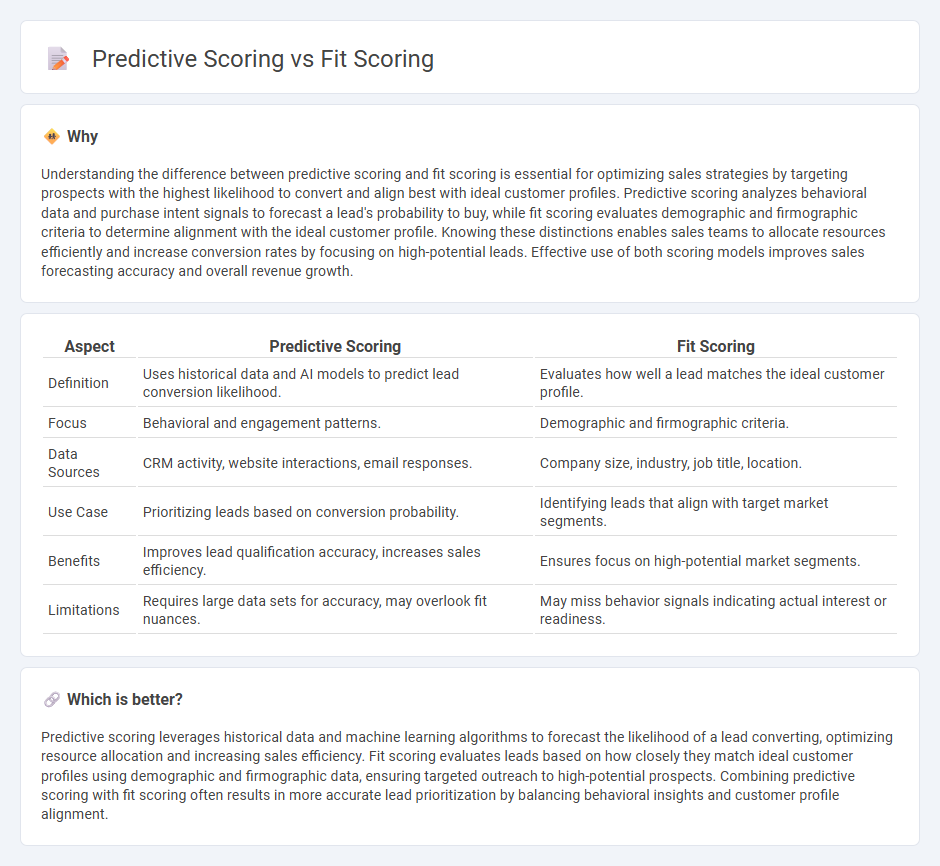
Predictive scoring leverages historical data and machine learning algorithms to forecast the likelihood of a lead converting into a customer by analyzing behavior patterns and engagement metrics. Fit scoring evaluates leads based on demographic and firmographic criteria, aligning prospects with ideal customer profiles to prioritize sales efforts effectively. Explore how combining predictive and fit scoring can enhance your sales pipeline accuracy and efficiency.
Why it is important
Understanding the difference between predictive scoring and fit scoring is essential for optimizing sales strategies by targeting prospects with the highest likelihood to convert and align best with ideal customer profiles. Predictive scoring analyzes behavioral data and purchase intent signals to forecast a lead's probability to buy, while fit scoring evaluates demographic and firmographic criteria to determine alignment with the ideal customer profile. Knowing these distinctions enables sales teams to allocate resources efficiently and increase conversion rates by focusing on high-potential leads. Effective use of both scoring models improves sales forecasting accuracy and overall revenue growth.
Comparison Table
| Aspect | Predictive Scoring | Fit Scoring |
|---|---|---|
| Definition | Uses historical data and AI models to predict lead conversion likelihood. | Evaluates how well a lead matches the ideal customer profile. |
| Focus | Behavioral and engagement patterns. | Demographic and firmographic criteria. |
| Data Sources | CRM activity, website interactions, email responses. | Company size, industry, job title, location. |
| Use Case | Prioritizing leads based on conversion probability. | Identifying leads that align with target market segments. |
| Benefits | Improves lead qualification accuracy, increases sales efficiency. | Ensures focus on high-potential market segments. |
| Limitations | Requires large data sets for accuracy, may overlook fit nuances. | May miss behavior signals indicating actual interest or readiness. |
Which is better?
Predictive scoring leverages historical data and machine learning algorithms to forecast the likelihood of a lead converting, optimizing resource allocation and increasing sales efficiency. Fit scoring evaluates leads based on how closely they match ideal customer profiles using demographic and firmographic data, ensuring targeted outreach to high-potential prospects. Combining predictive scoring with fit scoring often results in more accurate lead prioritization by balancing behavioral insights and customer profile alignment.
Connection
Predictive scoring analyzes historical customer behavior data to forecast the likelihood of a lead converting, enhancing sales efficiency by focusing on high-potential prospects. Fit scoring evaluates how well a lead matches the ideal customer profile based on firmographics, demographics, and technographics. Integrating predictive and fit scoring provides sales teams with a comprehensive assessment, combining behavioral insights and suitability metrics to prioritize leads effectively.
Key Terms
Lead Qualification
Fit scoring evaluates a lead's alignment with ideal customer profiles by assessing demographic and firmographic criteria such as company size, industry, and role, while predictive scoring uses historical data and machine learning algorithms to forecast the likelihood of a lead converting based on behavioral patterns. Lead qualification improves when integrating fit scoring to identify the right prospects and predictive scoring to prioritize those showing intent signals, optimizing sales focus and resource allocation. Explore how combining these scoring methods can enhance your lead qualification strategy and boost conversion rates.
Data Modeling
Fit scoring evaluates how well a candidate's qualifications match a job's requirements using historical hiring data, emphasizing similarity metrics and profile alignment. Predictive scoring leverages advanced data modeling techniques like machine learning to forecast a candidate's future job performance and tenure based on patterns extracted from diverse datasets. Explore our detailed analysis to understand the impact of data modeling on enhancing recruitment accuracy and decision-making.
Predictive Analytics
Predictive scoring uses historical data and machine learning algorithms to forecast future outcomes, making it a key component in predictive analytics for decision-making. Fit scoring evaluates how well a prospect aligns with an ideal customer profile based on demographic and firmographic data, often used in early-stage qualification. Explore how predictive scoring enhances business strategies by improving accuracy and driving growth.
Source and External Links
Best Practices for Utilizing Fit Scores in Talent Assessment | Bryq - Fit scoring in talent assessment provides a standardized, objective measure (on a 1 to 10 scale) of how an individual's performance and attributes compare to a norm group, helping to evaluate their fit for a specific role and supporting informed hiring decisions.
What is a Fit Score? - TalentClick - A Fit Score quantifies how closely a candidate or employee matches an ideal profile for a role, categorized by ranges with color codes (green for good fit, yellow for possible fit, red for low fit), and is used to guide hiring and talent management decisions.
Lead Conversion Starts with Signals - Use Fit Scoring or Lose Business - In lead scoring, a Fit Score numerically represents how well a lead matches an ideal customer profile based on firmographic and behavioral criteria, helping prioritize leads with higher potential for conversion using weighted factors processed via machine learning.
 dowidth.com
dowidth.com